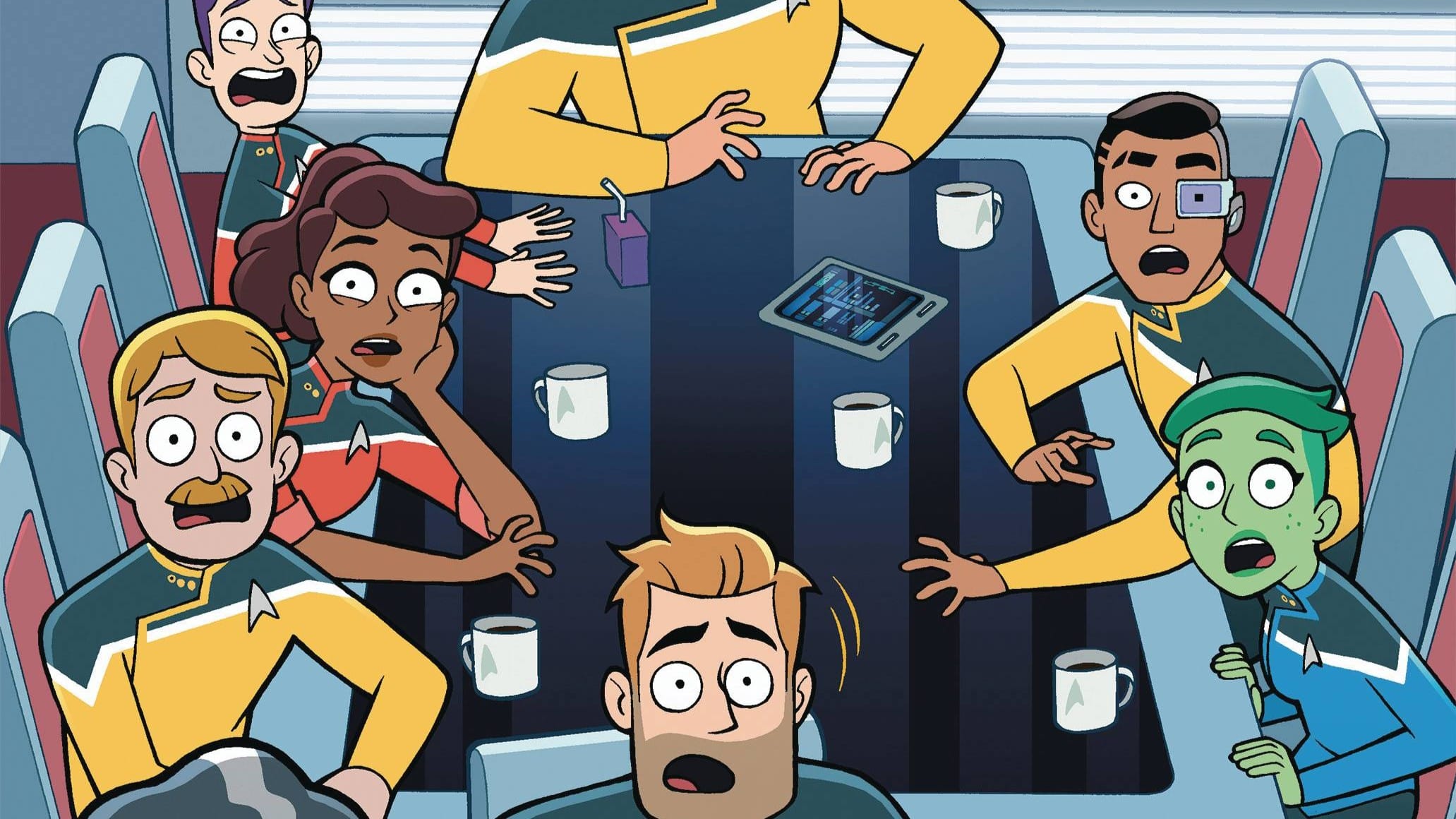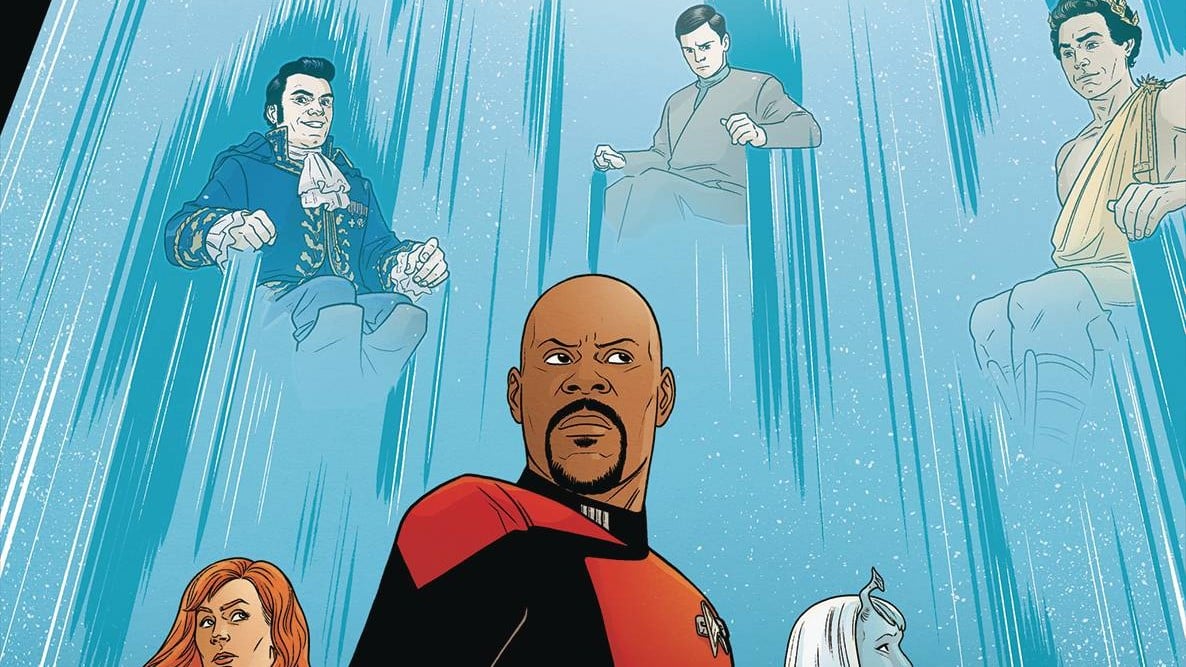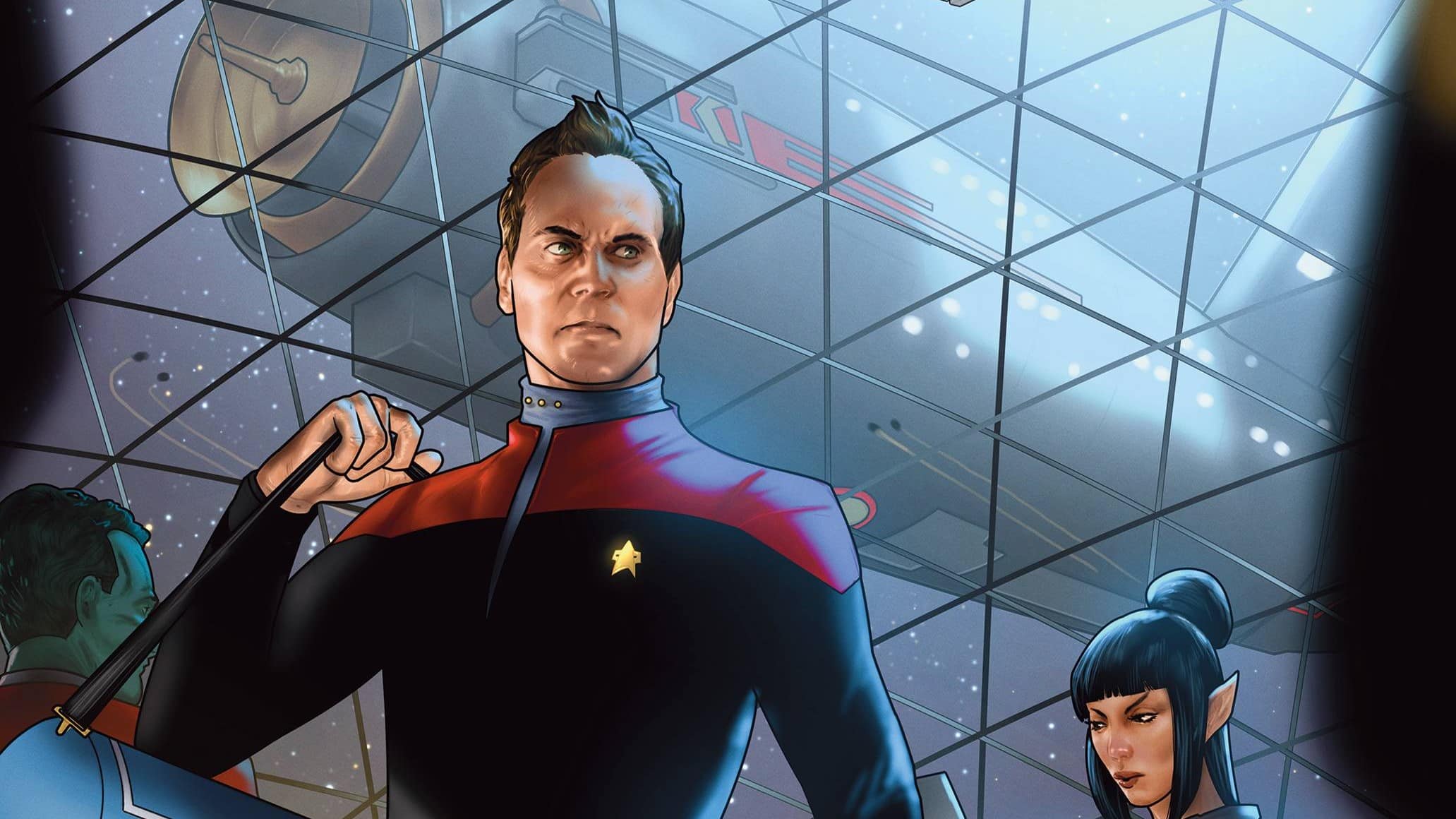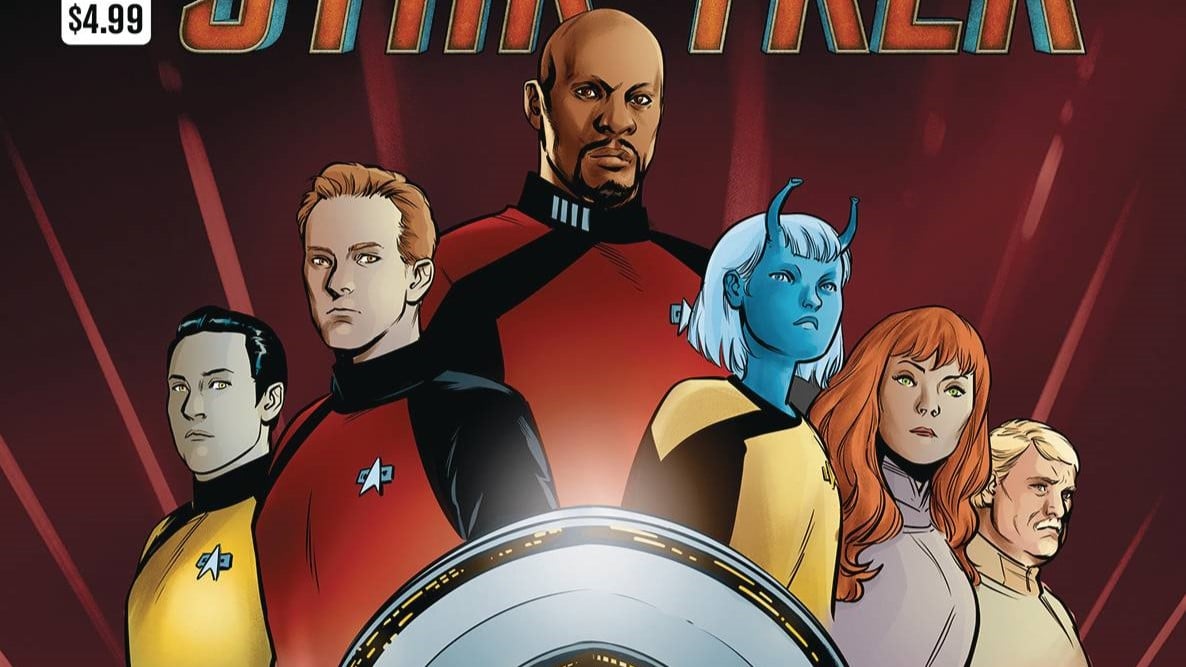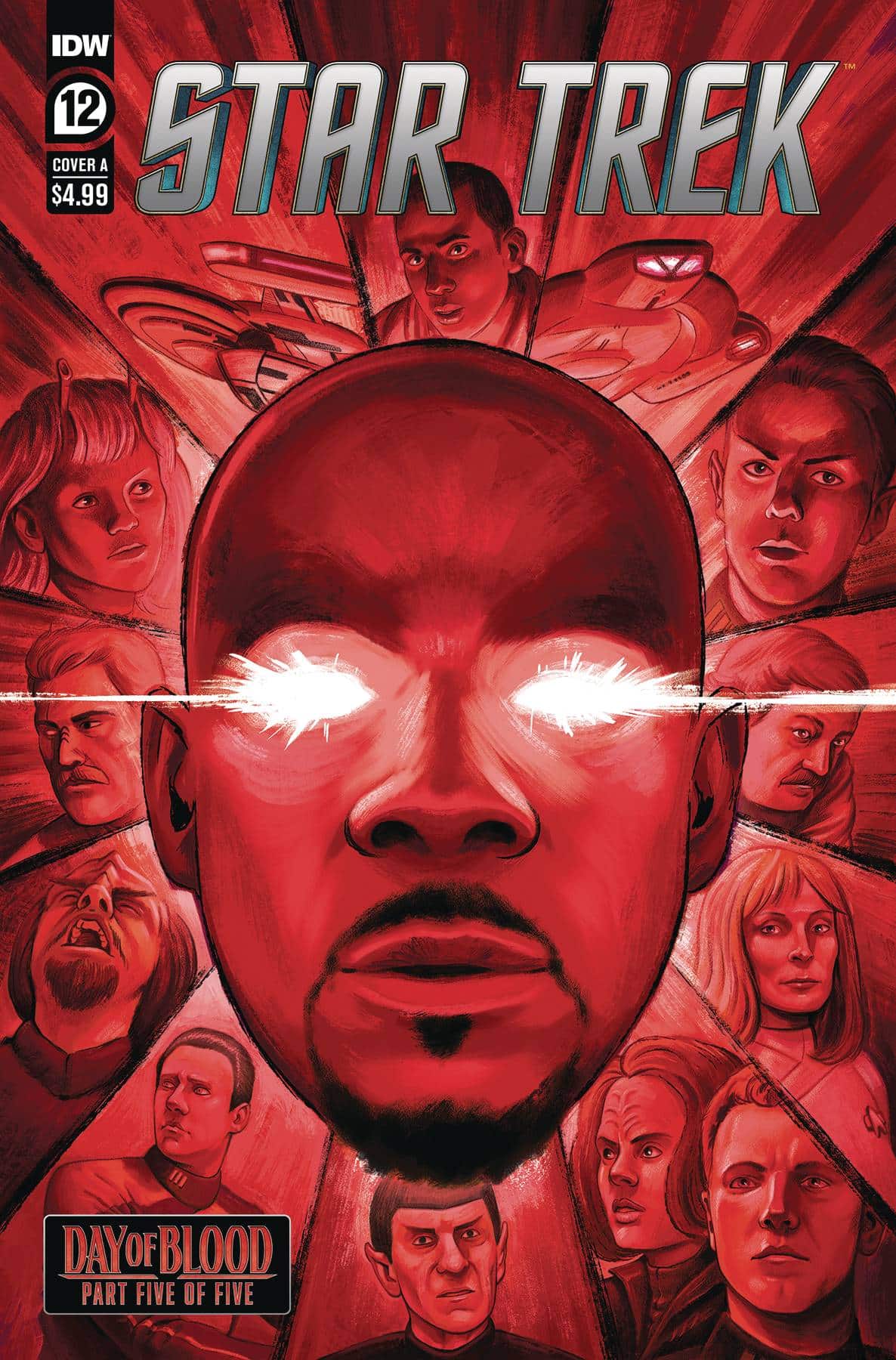A new batch of Trek Tales hit especially close to home in our newest “Trek Talks!”
Star Trek #28, written by Collin Kelly & Jackson Lanzing with art by Tess Fowler and letters by Clayton Cowles. Star Trek: Defiant #23, written by Christopher Cantwell, with art by Ángel Unzueta, colors by Marissa Louise and letters by Clayton Cowles. Star Trek: Lower Decks #3, written by Ryan North with art by Jack Lawrence, colors by Charlie Kirchoff and letters by Clayton Cowles.
Mark Turetsky: Well Matt, since last we trek talked, a madman has taken over and has proceeded to twist the world into his own evil creation.
I’m talking, of course, about Lore activating the Orb of Destruction in the Pleroma and unmaking the entire Star Trek Universe. Of course, there’s still plenty of adventure to be had both inside and outside of that universe!
Matt Lazorwitz: Absolutely! We have ancient Bajor. We have Klingons fighting capitalism. We have the Cerritos in a moral quandary. It’s a heck of a month for Star Trek comics.
Broadswords & Bajorans

Mark: Star Trek #28 tells the story of Benjamin Sisko being transported to ancient Bajor after seeking refuge in the Bajoran Wormhole, the one remaining feature of the unmade universe. The first thing I’d like to address is the artwork in this issue. The guest artist for this one (and the upcoming issue #29 as well) is the amazing Tess Fowler. Tess first came to my attention as the first replacement artist on the Image series Rat Queens.
Her career since then has had its ups and downs, to say the absolute least, but recently, she’s been creating incredible watercolor paintings of Star Trek characters that she’s been posting on her socials. They really capture the essences of the characters, and I’m guessing they’re what caught the attention of the Star Trek team to come in to do this guest run. Her art here is absolutely tremendous. Each page is fully painted, and the world of ancient Bajor she creates is not only lush and detailed, but changes as the story progresses, with Sisko leading the Bajorans through an agricultural revolution into something of a renaissance for the Bajoran civilization.
Matt: See, now I almost regret completely cutting myself off from social media (almost); I would love to see those paintings!
Fun fact: we recently had writers Jackson Lanzing and Colin Kelly on the CXF Interview Podcast, and they said that the Star Trek thing Fowler most wanted to draw was Bajorans, which she didn’t know coming in, so that worked out well for both her and for those of us reading, because Star Trek #28 is a stunning looking comic. The evolution of Bajor, and Sisko aging slowly, both look tremendous.
Mark: Before we get to the major events of the comic, there’s an odd thing, and that’s the inconsistency with how Star Trek #27 ended. In that issue, the Theseus flies through the wormhole and Sisko wakes up on a street in a Bajoran village (reminiscent of his waking up on the streets of San Francisco in “Past Tense”). Here, he begins in a field, tortured by images of the ship, his crew and his family being torn apart by the unmaking of the universe. It could be that he ran off out of the village into the field. He might also have visions of the fate of the Theseus, but these aren’t things that we’ve seen on the page, so it’s a bit confusing.
The narration in Star Trek #28 is meant to take the form of the Bajoran sacred texts, and there are some interesting echoes of both Earth religion and Trek lore. One example is when the captions say, “In those days, he walked among us.” Compare that to Bereshit 6:4, translated in the King James version as, “There were giants in the earth in those days.” The “giants” here are actually Nephilim in the Hebrew, which is one of those words found in the Torah that we don’t actually have a good grasp on. It might be related to the Hebrew for “to fall,” which, in this case, Sisko certainly counts as, since he came out of the sky. They also might be the offspring of divine beings and humans; again, like Sisko. It might also mean the heroes of the older world, which, you get the idea. So, to me, I don’t doubt this is intentional on the part of Kelly and Lanzing.
There’s another reference to the book of Bereshit later on, where the narration tells us, “And then he walked with us no more.” Compare with, “Enoch walked faithfully with God; then he was no more.” I made this connection back when discussing issue #21, where Sarah invites Benjamin to walk with her. But here, it doesn’t refer to Enoch ascending bodily to heaven, it refers instead to Sisko becoming a mountaintop hermit, removing himself from worldly concerns, or more accurately, to sulk in a cave for a while.
Matt: See, this is why I need to read more of the Bible. If this were Shakespeare, I’d be bouncing around with all the knowledge, but my background is decidedly secular.
Mark: There’s a big reveal in this issue that seems to go unremarked-upon. It’s that Bajor isn’t just the planet that’s next to the wormhole and therefore historically tied to its inhabitants. It’s in fact a planet created by The Prophets for the express purpose of Sisko having a place to spend this time outside of the universe. It’s right there on the first and second pages: “It is said all who beheld Bajor loved her… except the Sisko, for whom she was made.” Not only that, the inhabitants of Bajor have no conception of a universe outside of Bajor, its five moons, and presumably its sun. We also learn about the first Kai, which is the name of the first person to meet Sisko after he arrives. We see the emergence of the first Pagh Wraiths (here they are Bajorans who reject Sisko’s teachings, rather than evil counterparts of The Prophets).
Matt: But… what if they are the evil counterparts to The Prophets? What if all of this is in the Celestial Temple, in that non-lnear space, and these Bajorans are all, in fact, The Prophets living out some kind of strange, linear and temporal existence?
Like I said, my own Biblical knowledge is slim, but so many of those Biblical figures are historically apocryphal, so who’s to say that the Kai here isn’t a real figure but something that was passed down as knowledge rather than a person. And The Sisko isn’t mentioned by name in any of the Bajoran scriptures as such, or he would have been thought to be The Emissary simply by being named Sisko. The Prophets call him The Sisko, not the Bajorans. What if all of this is yet another of The Prophets’ strange experiments in understanding liner existence, even as it ends? The Pah-Wraiths in this case are working along the lines of Lucifer, who would not kneel before mortal man. The Pagh-Wraiths reject Sisko, this linear being, and thus reject the orthodoxy, and when what was made wrong is set right, the Pagh-Wraiths are cast out. It’s the kind of non-linear thing we expect from The Prophets, as everything is happening at once, so the Pagh-Wraiths exile happens due to something that by our reckoning is happening NOW, even though to them it was THEN.
I don’t necessarily think that is right. As a matter of fact, I’m pretty sure it’s not. But it’s a fun theory to noodle around with. And I might not be understanding something. Shaka, when the walls fell, and whatnot.
Mark: That’s a really good thought! You’re absolutely right in that the sacred texts tend to be prophecies, things that The Emissary or whoever will be doing. It’s not about what The Sisko did in Bajor’s ancient past. Is he even called The Emissary in this issue? And it makes so much sense: Sisko didn’t fly to Bajor, he flew into the Celestial Temple, so that’s where he is. I think you’ve cracked this case wide open.
Alexander And The Terrible, Horrible, No Good Very Bad System Of Economic Oppression

Matt: Science fiction, at its best, holds a mirror up to the anxieties of the times. Nearly all the Treks have had AI-centric villains since the Paramount Plus return, whether it’s Control in Discovery, the AI in season 1 of Picard, or the Texas class ships and Badgey in Lower Decks. Heck, the big bad on Seth McFarlane’s Next Gen love letter, The Orville, turned out to be an AI race. And AI has been one of the big fears we as a culture have been grappling with of late. So maybe, with the way things have been the past few weeks, rampant capitalism as a villain was appropriate for the A-plot of Star Trek: Defiant #23.
Mark: Rampant capitalism might also be the villain of Cantwell’s excellent Halt and Catch Fire as well. And it’s also telling that Menum, the corporate overlord in charge of the atrocity that is Archanis Inter-Corporate, isn’t some alien stand-in for hyper-capitalism like the Ferengi. He’s a former Federation colonist. It’s nice to think that in Star Trek’s post-capitalist future, once those issues are solved, they remain solved. But societies can backslide, sometimes in utterly catastrophic ways. And putting the wealthiest person in charge of a society will only lead to more exploitation and death.
Maybe if it were a Klingon in charge of the mining operation, it would be couched as the strong rightfully exploiting the weak to do the work of mining, under the guise of the honorable order of society, leading to environmental disaster, but that metaphor is much more 1991.
Matt: That’s true, but it’s not a Klingon, it’s just a sleazy human oligarch. Star Trek so often exists in areas of moral grey. Well, maybe not grey exactly, but not the clear black and white of Star Wars. Ethical questions are one of the foundations of Star Trek. But for Alexander’s Quv ritual to move forward, we needed something more absolute. A moral wrong that means he must act with compassion (even if the Klingon’s don’t have a word for that).
Mark: And the comic is very clear that the Federation and the Klingons are letting this happen in the name of diplomatic convenience, turning a blind eye to the horrors because they don’t want to be seen as overstepping.
Matt: Worf and Alexander’s relationship is, as it has ever been, so strained. I can’t help comparing it to Ben and Jake Sisko, especially as so much of what Ben wants to do is set the universe right so he can go back to his son. Here, Worf is doing everything he can to try to set that relationship right, even if it is awkward and painful. And including Martok. Good ol’ gruff Martok. Love that guy.
Mark: If only every powerful empire had a leader who gave such a damn about the exploitation of others! So much has been written elsewhere about Worf being a bad dad (and about Sisko being an absolute godsend for representation of African American fatherhood in the 90s), so I don’t want to retread that too much. But at this point, at least Worf’s trying? The tragedy here is that Worf rejected his adoptive parents’ Belarussian Jewish culture, he strove to be the ultimate Klingon man, and they still loved him and accepted him. And aside from the usual feeling of embarrassment when they show up at his work, he has a good relationship with them.
In the case of Alexander, Worf was both unready and unwilling to be a parent, and this and the main Star Trek title have done an amazing job of deepening that relationship and that characterization of Alexander, and showing just what becomes of those angry, neglected young men in the wake of certain political movements.
But even here, where Worf has decided not to give up (yet again) on his son, it’s not father to son, it’s not man to man. It’s within the codified strictures of this ritual. It’s him once again looking at his life, saying, “oh yeah, there’s a Klingon ritual for that” and applying that strict honor code to things. I hope it works this time, because it really hasn’t in the past.
I also want to take a moment to talk about the current Defiant B-plot: O’Brien’s personal mission to destroy the self-replicating mines he had a hand in creating during The Dominion War. I’ve absolutely loved O’Brien’s characterization during this and the previous arc of this series. When he’s confronted in his classroom and called a war criminal, he loses his temper, but he’s also the type of man who doesn’t just dismiss the accusation, because he knows that he bears some responsibility for the use of the weapons he’s designed, and he sets out to make things right.
Way back in TNG’s “The Wounded,” Miles has this incredible scene with a Cardassian in Ten Forward, where he reflects on his service in the Cardassian war, and he tells a story about vaporizing a Cardassian soldier. He says, “I’d never killed anything before. When I was a kid, I’d worry about swatting a mosquito. It’s not you I hate, Cardassian. I hate what I became because of you.”
You can draw a line between that episode that aired in 1991 straight to here.
Matt: “The Wounded” is one of my top 10 Next Gen episodes, and criminally underrated, most notably for that exact scene. It added layers to the generally one-note O’Brien, and I think it was responsible for him getting the DS9 role, metatextually.
There’s a fandom observation/joke about how O’Brien is a trauma magnet, from the events talked about above, to his numerous injuries, to losing his daughter to the timeline for a bit and having her come back feral, to being in a psychic prison for hours that felt like 20 years for a crime he didn’t commit (he’s also the Most Important Man in Starfleet History). Whether or not he actually experienced more trauma than, say, Riker, or most of the cast of Voyager is up for debate when you really think about it, but there’s something about both his nobility and his very grounded nature that makes him something different from what we’re used to.
He doesn’t own a vineyard or come from a long line of Starfleet officers. He’s not an android or the son of a Vulcan diplomat. He doesn’t have the memories of generations of Trill passed down to him, or serve as the Emissary of the Prophets. He’s not a reclaimed Borg drone. He’s just a working man. And those working man values, that sense of responsibility, as well as a knack for jury rigging pretty much anything, is what makes O’Brien such a notable character. We only get four pages in this issue back on the titular Defiant, which is ok as there was a lot to do with Alexander in this issue, but I’m hoping we get some more next issue.
Mark: Hear, hear!
I’m At The Combination New Universe and Metastable False Vacuum Decay

Matt: I tell you what, babes, this arc is the one I would hand to anyone who says that Lower Decks is just a silly little comedy show (looking at you, Brother Will Nevin). We have high science fiction, complex moral dilemmas, a “real world” Kobayashi Maru and a downbeat ending. That isn’t standard for Lower Decks, and there is still some comedy in here, but this basic storyline is like something you would have seen in one of the non-animated series; I could absolutely see this as an episode of TOS or TNG.
Mark: One thing I love about this story, apart from the human drama of it, is that it’s based on a real scientific hypothesis, false vacuum decay. Star Trek, for all that I love it, is not always great about the “science” side of science fiction. Often, the science trappings are there to serve the story, as it should be. But here, we have a story that could just as easily be “there’s a hole in space and its eating up all our space,” and that would be fine, the human drama of it would be just as good. But instead we get this extra layer of, “here’s a real, actual, (hypothetical), thing, how would we perceive that as an existential threat?” And the story builds out of that.
It’s been interesting seeing how writer Ryan North et al handle this third ongoing Trek series which is, by necessity, disconnected from the other two (the Cerritos crew we love doesn’t overlap in the timeline with the current time period of Star Trek and Defiant). They’ve got a kind of freedom here to explore all kinds of different stories, but also story structures. We can have one shot issues, we can have short arcs, who knows, we might get an epic down the road.
Matt: I want to shout out North’s non-fiction book, How to Take Over the World: Practical Schemes and Scientific Solutions for the Aspiring Supervillain, a book that takes real science and applies it to supervillain schemes. The guy who wrote that is absolutely someone who can bring the science into the science fiction of Star Trek.
One of the human drama elements here that stuck out to me was Rutherford’s questioning of whether or not he should be able to calculate faster. Working on a licensed comic for a property that is still running is a tricky thing, at least according to creators I’ve interviewed. Even when the license holder is friendly, there are a lot of dancing between the raindrops moments, and things you have to alter to not overlap with what is going on in the “main” property.
This arc had to have been written while Lower Decks Season 5 was airing (or about to), and I would love to know if that bit was something North had planned himself, or was something that Paramount fed him, as those beats here feed very nicely into his arc in the final season that reaches its climax in the final episode where [SPOILERS] he decides to remove his implant and live, and engineer, at a slower pace. Other than “after the main cast has been given their promotions,” we don’t know exactly when this takes place, but I would suspect sometime in Season 4, since Tendi is still around and Boimler isn’t at any point in his unfortunate facial hair phase, so it’s a nice touch to lay seeds for things that we the reader know about without it being so obvious and clunky.
Mark: I do recall them mentioning meeting their “Dos Cerritos” counterparts, which means this is before Boimler’s beard has started growing in. I’ve got to wonder if, going forward, this comic will stay in this nebulous time period, or if it’ll be allowed to continue post “The New Next Generation,” which… I’m not sure how I’d feel about, since, without getting into spoilers, there’s a pretty big shakeup that happens in that finale.
Matt: I have been wondering the same thing. Avoiding spoilers as well, a post-TV series Lower Decks story would be very different, so I would expect us to stay in the “between the raindrops” period for the foreseeable future.
Mark: Hey, I’m still holding out hope that someone picks up another season. It happened for Futurama [Editor’s Note: like, several times]!
Matt: Until we get a “Planet of the Moopsies” episode, I will continue to wish for more episodes. And after that, well, we’ve reached peak TV and nothing else would be needed.
Mark: Thanks for stepping in, Matt! It was a pleasure.
Prepare Yourself for Warp 10 Excitement!
- I don’t guest here often, so I will once again attempt to plug another CXF project. Head over to the CXF Interview Podcast page, where we have interviewed both Lanzing & Kelly of Star Trek and Ryan North of Lower Decks in the past couple weeks. We have some great conversations in there that I think you’ll dig.
- “He told us of something called the Celestial Temple. Though it only existed in his mind, he said it belonged in our skies.” An interesting phrasing, compare to Benny’s “That future, that space station, all those people, they exist in here. In my mind” in “Far Beyond The Stars.”
- I love how Sisko’s outfit, a red robe over a gray tunic, mirrors his post-First Contact uniform.

